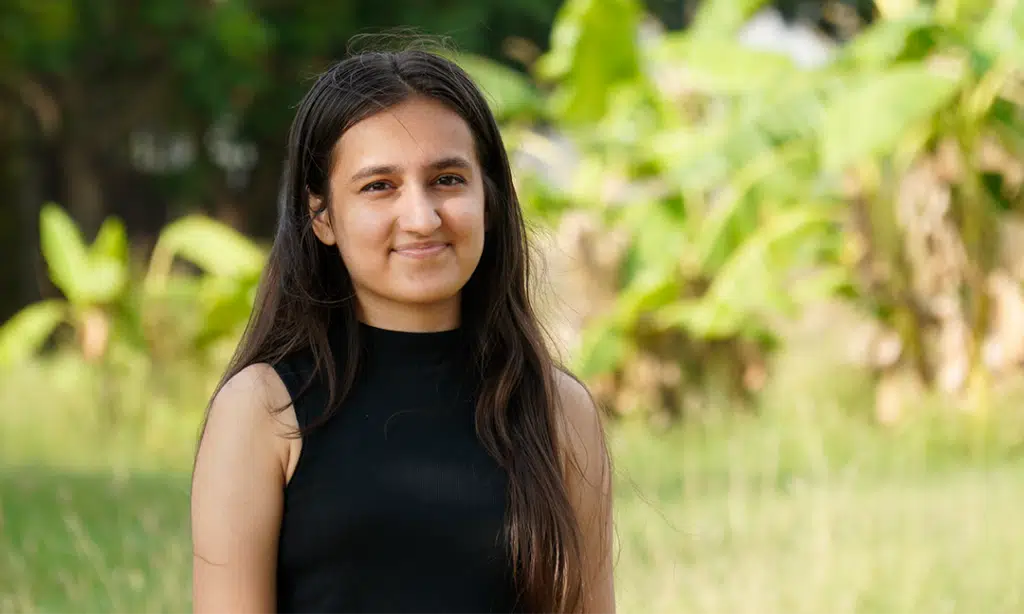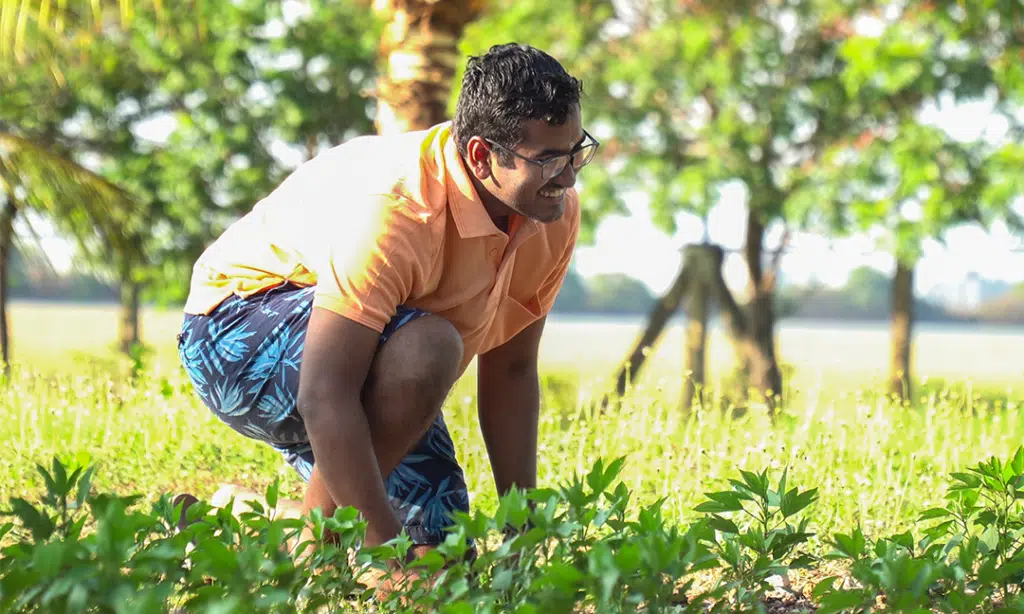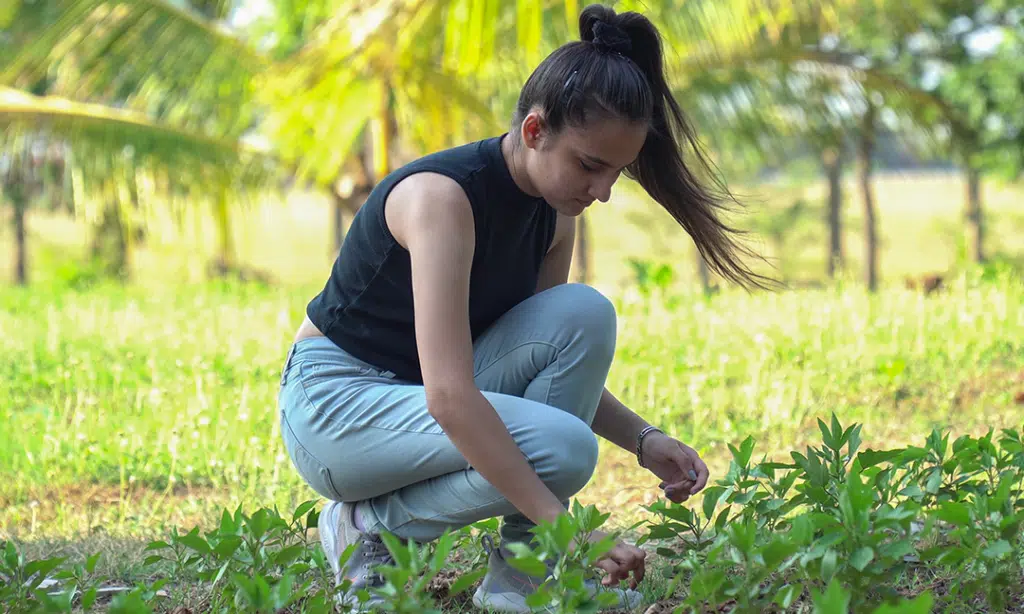The Krea University campus centres around the ethos of holistic sustainability. Several projects and initiatives, aligned with the UN Agenda for Sustainable Development, aim at increasing resource efficiency, reducing environmental footprint and fostering biodiversity on campus. In doing so, Krea’s green campus continues to promote the values of efficient and accountable use of scarce resources, and supports the wellbeing of all members of the Krea community.
Krea students champion some of the key sustainability-focused initiatives on campus. Three Krea students — Pratibha Khullar, Avinash Panakkal and Sai Balaji Suresh — graciously agreed to take us for an informative and enjoyable Sustainability Walk, showcasing the landscape, infrastructure and conservation practices that are part of this thriving campus that embodies the principles of sustainability.
Avinash, a first-year student at Krea, asserts how important the values of environmentalism and sustainability are for the Krea community. “Here at Krea, we place great emphasis on sustainability, be it in terms of environment, wellbeing or student life”, he says. It is this awareness about the impact of every individual and collective action, that makes Krea an educational hub of inclusiveness, creativity and innovation, where learning is not limited to the traditional classroom.

The Butterfly Garden
Our Sustainability Walk begins with a visit to the Butterfly Garden. Inviting us to explore this beautiful part of the campus, Pratibha, a first year student at Krea, tells us that hundreds of butterflies can be observed in this area every day. “There are dozens of butterfly species seen throughout the year; some of the easily identifiable ones are Striped Tiger, Plain Tiger, Glassy Tiger, Common Grass Yellow, Cerulean, Oriental Grey Pansy and Crimson Rose”, she specifies. The Butterfly Park provides both a visually appealing landscape, as well as cover and protection for butterfly and other pollinator insects.

Biodiversity Zone
As we walk along Krea’s famed Perimeter Pathway, we reach our next sustainability landmark — the Biodiversity Zone. “The water body and the surrounding area are part of a designated biodiversity zone at Krea”, says Sai, a second-year student at Krea. He explains that the zone acts both as a flood control and a large reservoir for collecting rainwater. Due to the high water table and rains, water is available throughout most of the year. This water is used for irrigating Krea’s entire landscape. This is a significant water conservation measure. “We can maintain and keep the campus green thanks to this”, he adds with a sense of pride. These man-made water canals also contribute to the campus microclimate.

Although the entire 40-acre campus is a lush green space, we have dedicated a three-acre area at the north-west of the campus for indigenous and locally-adapted flora, with the purpose of building and nurturing a small self-sustaining forest ecosystem. The biodiversity zone is already becoming a sanctuary for many species of birds, butterflies and other insects that are frequently spotted on campus.
Sai is aware of the value this zone provides to the Krea community and the larger environment. He tells us that the water body and the greenery support many types of insects, birds and fish. There are 37 identified varieties of bird seen and/or living on campus. Among them are the Black Drogo, Indian Roller, Pied Kingfisher, Indian Cormorant and Spotted Owlet. “One of my favourites is the Golden Oriole, which has a beautiful yellow colour and flies around in pairs,” says Sai.
Sai is very enthusiastic about taking the next steps. “We plan to vegetate this zone with native flora and nourish a natural ecosystem; in addition to the existing trees, we plan to plant more than 500 local forest species of trees,” he explains. Since the project is based on the principles of permaculture, the zone has a potential to become a ‘food forest’ vegetated with green leafy vegetables, microgreens, amla, lemon and pomegranate trees. Through several student-driven clubs, such as the Nature Club, Ecology Club and the Social Outreach club, students can actively participate in this project and develop a sense of ownership for biodiversity conservation.

Organic Farm
A small nursery of plant saplings and seed depository is set on campus. A student-led initiative, called ‘Community Organic Farming’, has also started off successfully. The initiative aims at promoting sensitivity towards environmental issues. It provides students a chance to get hands-on experience of what it is like to be working on land and growing crops from scratch. This experience makes one aware of where our food comes from, and instils a feeling of appreciation for the land and for the farmers.
“On this land, we plan to grow a variety of locally sourced organic vegetables”, explains Pratibha. Before expanding the project on a larger scale, the students involved in the project selected a small patch of land to work on as a prototype. They planted a local variety of spinach, after preparing the land to make it cultivable. “After almost a month-and-a-half of hard work, daily waking up early in the morning to work on this land, the result is truly rewarding,”Pratibha concludes with a smile.

Solar Panels
With a constant effort to reduce the carbon footprint, and a vision to make Krea carbon neutral one day, there is a fully-operational 520 kWp solar photovoltaic installation on campus. The solar panels have produced a total of 750,000 kWh of renewable energy. Avinash aptly draws our attention to the importance of using solar energy as a renewable source of energy. “These solar panels help cover around 35-40% of our electricity consumption; they help reduce our CO2 emissions by an amount equivalent to that absorbed by 40,000 trees in one year,” says Avinash. Here are plans to increase the solar panel capacity gradually over the next few years, to produce more green electricity.
Sewage Treatment Plant
Our next sustainability spot on campus is the sewage treatment plant, which not only makes us less dependent on freshwater, but also reduces our overall carbon footprint associated with the process of procuring water through the Water Supply and Sewage Board of Sri City. Our treated water can be used for landscaping, cleaning external spaces, flushing, etc. Pratibha tells us that this is an innovative low-energy technology which involves nearly no moving parts except for the pumps. “All the wastewater from the campus gets treated here. All recycled water is used for the flushing requirements in the campus. This has helped reduce our dependence on the outside source of water. We aspire to make Krea water self-sufficient one day.”
Waste Segregation
As we enter the main Academic Block at Krea, Sai points out the colour-coded waste bins, strategically placed on each floor of the building. “We try to segregate all our waste on the campus by using separate, colour-coded bins for dry waste (such as paper and plastic), wet waste and e-waste,” he explains. The recyclable waste (like paper and plastic) goes to relevant vendors for recycling. Krea has already started a program for organic waste management. Krea will soon have its own compost facility, where all the wet waste generated on campus will be processed. Awareness about the importance of not wasting food is high among the Krea community. “The amount of food waste is quite low, since we make a conscious choice not to take more than we can eat”, says Sai, concluding our Krea Sustainability Walk.
Forthcoming Projects and Initiatives
Kshitij Amodekar, Associate Director – Design and Sustainability, Krea University, delineates the sustainability journey ahead, with several projects and initiatives already in the pipeline.
“Sustainability has various interpretations, and the applications are wide. We are striving to improve our understanding and delivery of these within the Krea community and the extended community around Krea University. While we work on this, we march on with various initiatives in the next year or so like biodiversity plantation, onsite organic waste management, planning new buildings with energy saving systems and planning for expanding our renewable energy capacity, etc. One of the most significant challenges of the 21st century is the human-environment relationship and our collective impact on our planet.”
Watch the Krea Sustainability Walk video here
